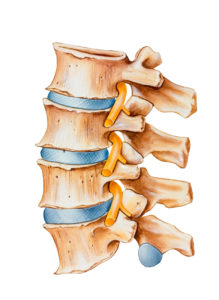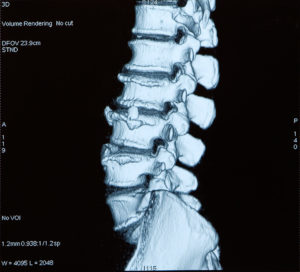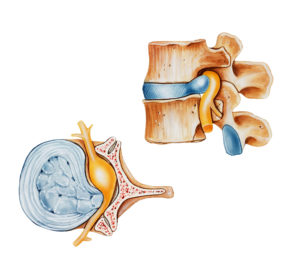Most patients have heard the phrase “slipped disc”, “ruptured disc” or “disc popped out”. While these are certainly descriptive terms, they can be somewhat misleading. What these terms are referring to is a disc herniation. Disc herniations are common, especially in the low back (i.e. lumbar spine), and at our practice we treat this condition regularly.
A lumbar herniated disc is a common cause of low back and leg pain. Discs, which act as shock absorbers for the spine, are located in between each of the vertebrae in the spine. Each disc contains a tire-like outer band (called the annulus fibrosus) that surrounds a gel-like substance (called the nucleus pulposus).
How Do Discs Herniate?
A herniation occurs when the outer band of the disc breaks or cracks and the gel-like substance from the inside of the disc leaks out, placing pressure on the spinal canal or nerve roots. In addition, the nucleus releases chemicals that can irritate the surrounding nerves causing inflammation and pain.
Most lumbar disc herniations occur as a result of sudden stress, such as from an accident. Sometimes they occur gradually, over weeks or even months. The risk factors that can contribute to the chances of a disc herniation, include:
- Aging. As we get older, discs gradually dry out, losing their strength and resiliency.
- Lifestyle choices. Lack of regular exercise, not eating a well-balanced diet, being over-weight, and tobacco use substantially contribute to poor disc health.
- Poor posture, incorrect and/or repetitive lifting or twisting can place additional stress on the lumbar spine.
Symptoms
Symptoms of a lumbar disc herniation may include the following:
- Dull or sharp pain in the lower back, intensified by movements or activities such as bending, coughing, or sneezing.
- Muscle spasms or cramping.
- Sciatica (pain, burning, tingling, and numbness that extends from the buttock into the leg or foot).
- Leg weakness or loss of leg function.
Diagnosis
Good treatment is always based on an accurate diagnosis. Our comprehensive diagnostic process includes:
- Medical history. We will talk to you about your symptoms, how severe they are, and what treatments you have already tried.
- Physical examination. You will be carefully examined by one of our spine specialists for limitations of movement, problems with balance, and pain. During this exam, we will also look for loss of reflexes in the extremities, muscle weakness, loss of sensation or other signs of spinal cord damage.
- Diagnostic tests. Generally, we start with plain x-ray films, which allow us to rule out other problems such as infections. CT scans and MRIs are often used to give us three-dimensional views of the lumbar spine and can help detect herniated discs.
Treatment for Lumbar Disc Herniation
The good news is that most cases of lumbar disc herniation do not require surgery! Long-standing evidence suggests that pain associated with a herniated disc often diminishes without surgical treatment within 4-6 months. Unfortunately, it is not possible to predict which cases will have natural resolution, and which will not. Thus, patients are usually prescribed non-surgical treatments initially to help relieve symptoms.
Non-Operative Treatment
A combination of the following treatments will be used with most herniated disc patients:
- Pain medications such as anti-inflammatories to reduce swelling and pain, muscle relaxants to calm spasms, and occasionally narcotic painkillers to alleviate acute pain.
- Heat/cold therapy, especially during the first 24-48 hours.
- Physical therapy exercises such as gentle massage, stretching, and strengthening exercises to decrease pain and increase flexibility.
- An epidural injection of anti-inflammatory medication. This is for patients who have severe pain or significant leg pain.
Surgical Treatment
If after non-surgical treatment the patient still has intolerable pain, or if there is evidence of neurological deficit (e.g. weakness in the calf muscles) then we may recommend surgery to treat the disc herniation.
To relieve nerve pressure and leg pain, surgery usually involves removing part or all of the damaged disc. This is called a discectomy. At our practice, this procedure can often be done utilizing minimally invasive techniques. Minimally invasive surgery uses smaller incisions and specialized technology such as microscopes and endoscopes (“mini-video cameras”). Microdiscectomy and minimally invasive techniques often result in quicker patient recovery times compared to traditional techniques, as they reduce trauma to muscles and minimize blood-loss during surgery.
Spine fusion is rarely necessary when a disc is herniated for the first time. If necessary, the space left by the removed disc may be filled with a bone graft – a small piece of bone usually taken from the patient’s hip. The bone graft or a bone substitute is used to join or fuse the vertebrae together. In some cases, specially designed instrumentation (such as rods or screws) may be used to help promote fusion and to add stability to the spine.
In addition to a discectomy, a portion of the bone covering the nerve may also need to be removed. This procedure is called a laminectomy.
Recovery
At our practice, most patients can begin getting out of bed on the same day surgery is performed. Activity is gradually increased and patients are typically able to go home within 24 hours after their procedure, depending on the extent of the surgery. There will probably be some pain after the procedure. However, we have pain medications available that will keep you comfortable.
At home, you will need to continue to rest. You will be instructed on how to gradually increase your activity. You may still need to take the pain medications for a while. However, pain and discomfort should begin to reduce within a week or two after surgery. We will discuss with you other techniques for reducing pain and increasing flexibility before you leave for home. We will also discuss with you a timeframe for when you can resume basic activities such as walking, driving and light lifting, and when you can return to more advanced activities such as work, sports and yard work.
At our practice your return to health is our primary concern. If you have any questions about your condition, your treatment, or your recovery, do not hesitate to call us.




